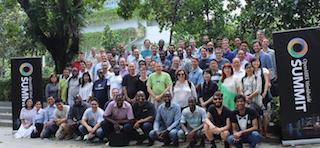open source products
See the following -
Girls' Skills Are Needed in Tech
 ChickTech is based in Portland but plans to be nationwide by 2016. After interviewing Jennifer Davidson about how ChickTech gets girls involved in tech, I have high hopes it's even sooner. The non-profit targets girls who would never nominate themselves to participate in a tech workshop and who wouldn't dream of a career in tech. Why? Because they've never had someone believe their skills were valuable in that world...
ChickTech is based in Portland but plans to be nationwide by 2016. After interviewing Jennifer Davidson about how ChickTech gets girls involved in tech, I have high hopes it's even sooner. The non-profit targets girls who would never nominate themselves to participate in a tech workshop and who wouldn't dream of a career in tech. Why? Because they've never had someone believe their skills were valuable in that world...
- Login to post comments
Is Open Source A Development Model, Business Model, Or Something Else?
 The OSD gives a clear definition of what open source software is, but doesn't provide much insight into how the adoption of open source affects a company's ability to build and deliver products or services that people want and need. Stated another way, there's still tremendous debate about the best ways to build a business based on open source. In this first of a multi-part series, I will lay the groundwork for understanding what products are, what product managers do, and how open source can be considered a supply chain. In future articles, I will go deeper into each of these topics, but I'll start by dissecting some common, but fundamentally confusing vocabulary.
The OSD gives a clear definition of what open source software is, but doesn't provide much insight into how the adoption of open source affects a company's ability to build and deliver products or services that people want and need. Stated another way, there's still tremendous debate about the best ways to build a business based on open source. In this first of a multi-part series, I will lay the groundwork for understanding what products are, what product managers do, and how open source can be considered a supply chain. In future articles, I will go deeper into each of these topics, but I'll start by dissecting some common, but fundamentally confusing vocabulary.
- Login to post comments
Managing The Open Source Product Roadmap
 Customers, as well as the sales and marketing teams who talk to them, love a roadmap. It gives them a sense of what is realistic and what is not. The roadmap is also at the heart of a product. Maintaining an up-to-date product roadmap keeps the product team focused on the customer and aligned around delivering what they need. The roadmap communicates both the strategic direction for a product and the company's perspective on problem solving.
Customers, as well as the sales and marketing teams who talk to them, love a roadmap. It gives them a sense of what is realistic and what is not. The roadmap is also at the heart of a product. Maintaining an up-to-date product roadmap keeps the product team focused on the customer and aligned around delivering what they need. The roadmap communicates both the strategic direction for a product and the company's perspective on problem solving.
- Login to post comments
OSEHRA Corporate Membership Doubles as Interest in Open Source EHRs Surges
The Open Source Electronic Health Record Alliance (OSEHRA) is pleased to announce that its Corporate Membership has doubled in the latter half of 2014. This expansion demonstrates a growing interest in open source and follows OSEHRA’s very successful 3rd Annual Open Source Summit. Read More »
- Login to post comments
Standardized Open Source Products Are The Key To Unlocking The Lock-In Trap
Mårten Mickos, CEO of Eucalyptus Systems, argues that when companies lock in to their own design and customizations, it’s as harmful as when they lock in to a vendor. Mickos explains why he thinks using standardized open source products is the best way to avoid both types of lock-in...
- Login to post comments
Team Bahmni at the OpenMRS Worldwide Summit
 ThoughtWorks first began contributing to OpenMRS in 2006 and since that time, we've had over fifty committers to OpenMRS in GitHub. Incidentally, one in every seven OpenMRS contributor in GitHub is a ThoughtWorker! Naturally, in 2013, when we had the opportunity to build Bahmni, an open source hospital information system, we choose OpenMRS as the underlying Electronic Medical Records System (EMR). Bahmni leverages the mature data model and APIs of OpenMRS, whilst providing an out-of-the-box system that can be immediately used by hospitals.
ThoughtWorks first began contributing to OpenMRS in 2006 and since that time, we've had over fifty committers to OpenMRS in GitHub. Incidentally, one in every seven OpenMRS contributor in GitHub is a ThoughtWorker! Naturally, in 2013, when we had the opportunity to build Bahmni, an open source hospital information system, we choose OpenMRS as the underlying Electronic Medical Records System (EMR). Bahmni leverages the mature data model and APIs of OpenMRS, whilst providing an out-of-the-box system that can be immediately used by hospitals.
- Login to post comments
The Changing Face of Public Health System Procurement
 The development and acquisition of public health systems is poised to change. Historically, public health agencies had the classic choice when it came to acquiring a new data system. Either they developed the system themselves – usually based on a belief that their requirements were “unique” – or they licensed a COTS/GOTS product from the limited choices available in a small market. Typically, agencies that chose to develop solutions were forced to use a waterfall approach as government procurement is not well suited to the flexibility of Agile systems development. Some agencies have been able to leverage open source offerings. While most do not have the wherewithal to support open source products themselves, many have formed strong partnerships with other organizations, both for-profit and nonprofit, to take advantage of these systems.
The development and acquisition of public health systems is poised to change. Historically, public health agencies had the classic choice when it came to acquiring a new data system. Either they developed the system themselves – usually based on a belief that their requirements were “unique” – or they licensed a COTS/GOTS product from the limited choices available in a small market. Typically, agencies that chose to develop solutions were forced to use a waterfall approach as government procurement is not well suited to the flexibility of Agile systems development. Some agencies have been able to leverage open source offerings. While most do not have the wherewithal to support open source products themselves, many have formed strong partnerships with other organizations, both for-profit and nonprofit, to take advantage of these systems.
- Login to post comments
ThoughtWorks Latest Technology Radar Highlights Emerging Trends in Open Source and Cloud Platform Technologies
 ThoughtWorks, a global technology company, today issued the latest Technology Radar, an assessment of trends significantly impacting software development and business strategy. The Technology Radar sets out the current changes in software development - things in motion to pay attention to based upon ThoughtWorks' day-to-day work and experience solving their clients' toughest challenges. "Our latest Technology Radar focuses on some exciting trends that are changing the way companies and tech practitioners deploy open source systems and Cloud and Platform as a Service (PaaS)," said Dr. Rebecca Parsons, CTO of ThoughtWorks.
ThoughtWorks, a global technology company, today issued the latest Technology Radar, an assessment of trends significantly impacting software development and business strategy. The Technology Radar sets out the current changes in software development - things in motion to pay attention to based upon ThoughtWorks' day-to-day work and experience solving their clients' toughest challenges. "Our latest Technology Radar focuses on some exciting trends that are changing the way companies and tech practitioners deploy open source systems and Cloud and Platform as a Service (PaaS)," said Dr. Rebecca Parsons, CTO of ThoughtWorks.
- Login to post comments
What Do Open Source Product Teams Do?
 Product managers and product marketing managers are the two most common product management roles, but product management can be further split into any number of roles, including competitive analysis, business strategy, sales enablement, revenue growth, content creation, sales tools, and more. With a very large product, even the product management role may be broken up into separate roles. You may even hear titles like technical marketing manager, product evangelist, and business owner, not to mention people-management roles for groups of individual contributor roles. For the purpose of this article, I refer to all of these roles collectively as "product management."
Product managers and product marketing managers are the two most common product management roles, but product management can be further split into any number of roles, including competitive analysis, business strategy, sales enablement, revenue growth, content creation, sales tools, and more. With a very large product, even the product management role may be broken up into separate roles. You may even hear titles like technical marketing manager, product evangelist, and business owner, not to mention people-management roles for groups of individual contributor roles. For the purpose of this article, I refer to all of these roles collectively as "product management."
- Login to post comments
Why Enterprises Embrace Open Source
I just finished attending two conferences: the Cloud Foundry Summit and the OpenStack Summit. Both were hives of activity, with attendance well up on the previous event. Most striking to me was the significant presence of large enterprise IT decision-makers — architects, directors of applications and operations, and even a sprinkling of CIOs.
- Login to post comments
Why I Fought for Open Source in the Air Force
 The AOC grew up out of a pick-up game of sorts between the users (Air Force personnel) and the vendors (commercial and government programs). The users simply bought what they wanted, and the vendors happily took their money and installed the systems. The result was a collection of standalone systems; each came installed with its own hardware and software, and there was very little sharing of resources between them. While the team made it work through sheer willpower, it was horribly inefficient, a maintenance nightmare, not user friendly, and agility was measured in decades. Our job was to take that mess and fix it...This was my first trial-by-fire experience that showed the true resistance within the Air Force and Department of Defense (DoD) to open source software...
The AOC grew up out of a pick-up game of sorts between the users (Air Force personnel) and the vendors (commercial and government programs). The users simply bought what they wanted, and the vendors happily took their money and installed the systems. The result was a collection of standalone systems; each came installed with its own hardware and software, and there was very little sharing of resources between them. While the team made it work through sheer willpower, it was horribly inefficient, a maintenance nightmare, not user friendly, and agility was measured in decades. Our job was to take that mess and fix it...This was my first trial-by-fire experience that showed the true resistance within the Air Force and Department of Defense (DoD) to open source software...
- Login to post comments